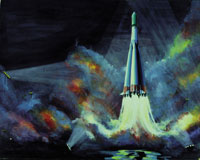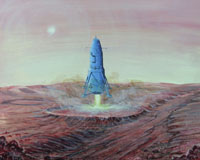
|
The Soviet Challenge In Space:
Illustrating The Threat
|
Manned Space Flight
Manned space flight symbolized
American and Soviet technological achievements and had significant
military applications. The technology used to place astronauts or
cosmonauts in orbit could also be used in military missiles. The
Soviets pursued a permanent presence in space, launching the Salyut
space station series beginning in 1971, followed by the Mir space
station in 1986. U.S. manned space flight efforts competed with
the Soviets in this race for prestige and technological superiority.
|
 |
Vostok
Manned space flight began
on April 12, 1961, with Yuri Gagarin's single-orbit mission. The
liquid-fueled, two-stage Vostok rocket that lifted Gagarin into
space was used to launch a variety of military and civilian spacecraft
from 1959 to the 1980s. During the 1980s, several years after this
illustration was made, the Soviets began using Vostok rockets to
place commercial satellites into orbit for other countries. Vostok
means "east" in Russian.
42k JPEG
Image courtesy DIA
|
| |
|
 |
Buran
Developed in the 1970s,
the Buran space shuttle resembled the U.S. Space Shuttle in design
and concept. The Soviets planned to use it to place satellites in
orbit and to resupply the Mir space station. The Soviets launched
the Buran only once, in 1988 without a crew. This illustration was
created prior to that launch. Russia canceled the program in the
early 1990s after the end of the Cold War. Buran means "snowstorm
in the steppes" in Russian.
36k JPEG
Image courtesy DIA
|
| |
|
 |
Mars Lander
The Soviet Union had
conceptual plans in the 1980s to send manned spacecraft to Mars
in the 1990s, even though its program to land cosmonauts on the
Moon failed. The mission would have required launching the spacecraft's
components into Earth orbit for assembly. The roundtrip journey
to Mars would have taken at least a year. This work from 1986 depicts
the envisioned landing on Mars. Post-Soviet Russia canceled the
program due to its expense and questions regarding its feasibility.
39k JPEG
Image courtesy DIA
|
|